The Value of Home Attic Ventilation
Author: Lee Polevoi | May 5, 2021
Home attic ventilation may not be at the top of every homeowner's concerns, but it's a crucial part of preserving a home's value and the safety of the people living in it.

A key role of ventilation is to maintain the right temperature in a home's attic. Regulating attic temperatures ensures the entire house is properly ventilated. Other benefits of ventilation include:
- Preventing the accumulation of moisture. Without this safeguard, condensation can lead to mold and mildew, and eventually to structural issues.
- Decreasing heating and air-conditioning costs.
- Helping preserve the quality of your roof and extend its life span.
Signs of Home Attic Ventilation Problems
While a thorough inspection of attic ventilation is best handled by a skilled roofing contractor, there are numerous ways for homeowners to check that the ventilation they have is doing its job.
One telltale warning sign is visible damage to roof shingles or warped wood framing in doors and walls from excess moisture and uneven temperatures. In extreme cases, blisters might form in wallpaper and paint. A room that is significantly cooler or warmer than the rest of the house, or general uneven temperatures in the home, should also be a tipoff.
Mold and mildew that result from poor ventilation may affect the health of people living in the home, especially if they have allergies or asthma. If someone in your family suddenly develops respiratory symptoms, and it's not due to an illness, new pet or seasonal change, it may be time to look in the walls for mold.
Seasonal Cues of a Ventilation Problem
The onset of winter brings additional threats to a poorly ventilated attic. Sometimes snow melts on the roof and then refreezes along the roof's eaves when temperatures drop again. This results in the creation of ice dams, which can lead to structural damage to walls and ceilings.
Summer brings dangers, too. Family Handyman suggests touching your ceiling on a hot, sunny afternoon. If the ceiling is hot, "it tells you that the attic is acting like a solar oven, raising your cooling bills and cooking the shingles."
Even houses in regions with moderate temperatures may be susceptible to damage caused by poor ventilation. The key is making sure your home has the right amount.
Industry Standards Guide Proper Ventilation Levels
Two types of vents are key to attic ventilation's effectiveness: intake vents under the eaves and hot air exhaust vents at the peak. There's some variation in industry standards for the right amount or types of attic ventilation, however.
According to Home Advisor, the standard is 1 square foot of ventilation "for every 300 square feet of ceiling space." The international standard for home ventilation is a minimum of 1 square foot of ventilation for every 150 square feet of attic floor space, notes the American Institute of Building Design.
A skilled roofing contractor can assess your specific attic ventilation needs, including the climate and structure of your house, and determine what the proper ratio should be. If your visual inspection of the attic suggests there might be problems, it's time to call the experts.